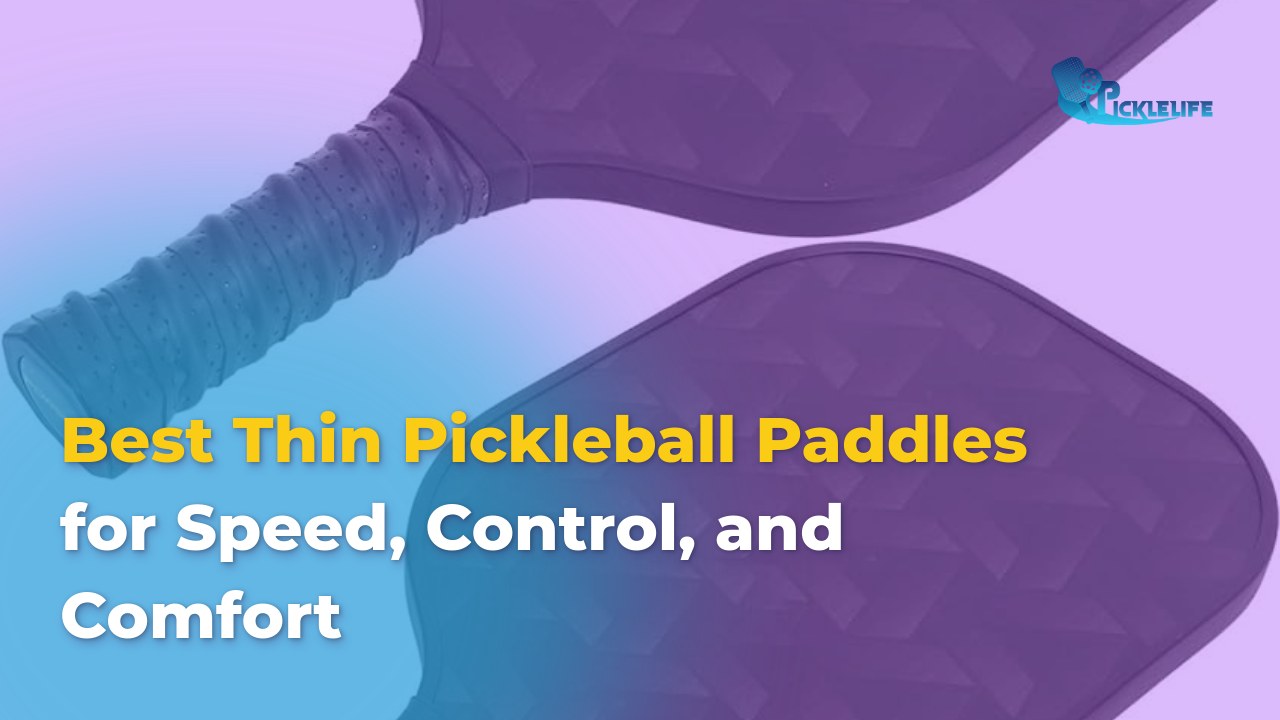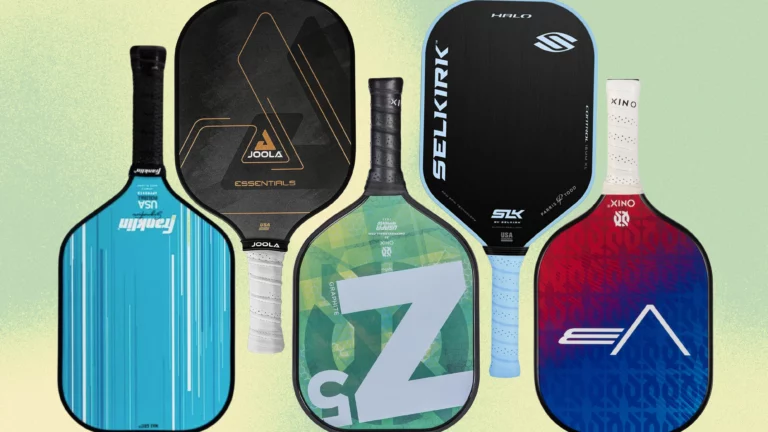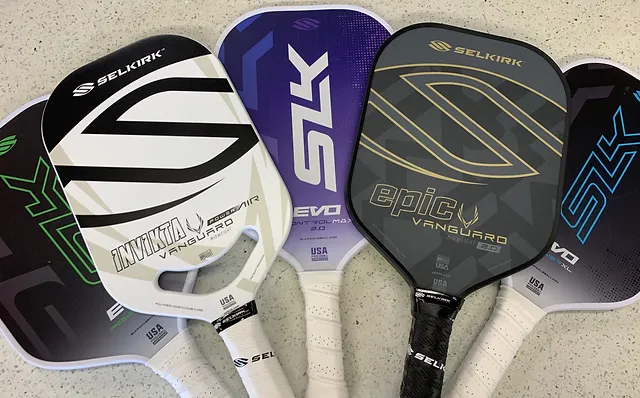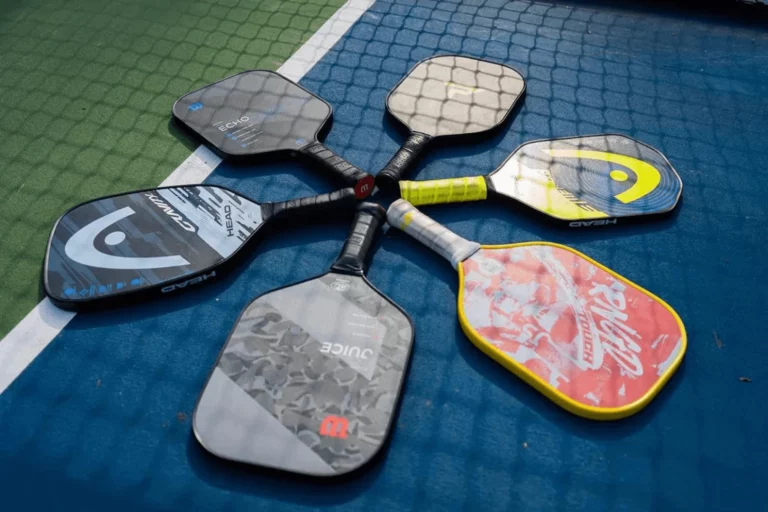Best Thin Pickleball Paddles for Speed, Control, and Comfort
Pickleball, a sport blending elements of tennis, badminton, and ping pong, has surged in popularity in recent years. Enthusiasts appreciate its inclusive nature and accessibility, drawing players of all skill levels to the courts. Central to a player’s performance is their choice of paddle, and thin pickleball paddles have carved out a specific niche within this growing community. With their unique attributes, these paddles provide a heightened sense of maneuverability and control, allowing players to quicken their pace and enhance their strategic play. Understanding the nuances of thin paddles from their defining features to the advantages they offer can provide players with essential insights into maximizing their game. This comprehensive guide delves into the world of thin pickleball paddles, helping players make educated decisions tailored to their game style.

What Are Thin Pickleball Paddles?
Thin pickleball paddles are generally defined by their noteworthy thickness, typically 13mm and under. Their construction imparts a distinctive combination of properties that appeals to a diverse range of players. Imagine trying to slice through a block of butter with a serrated knife versus a straight-edged knife the straight edge provides a more controlled and precise cut, much like how thin paddles allow for nimble strokes and strategic placements on the court.
Comparatively, thicker paddles, while often providing more power, can sacrifice some precision and touch, slowing down reactive play. In contrast, thin paddles favor agility, providing players the upper hand during fast exchanges. For many, this agility translates to improved shot selection and increased confidence, enabling them to make more aggressive strategic decisions. Hitting that bullseye of your opponent’s court becomes a more achievable feat as players hone their skills and adapt to the contours of the game.
The following table captures the specifications and characteristics of thin versus thick paddles:
| Feature | Thin Paddles | Thick Paddles |
|---|---|---|
| Thickness | 13mm and under | 16mm and above |
| Weight | Lighter (7-8.5 ounces) | Heavier (8.5-9.5 ounces) |
| Power | Moderately powerful | Highly powerful |
| Control | Enhanced | Moderate |
| Sweet Spot | Smaller | Larger |
| Maneuverability | Excellent | Good |
From this comparison, we discern astutely that while thin paddles excel in maneuverability and control, they traditionally offer a slightly smaller sweet spot, which players can overcome with improved precision and practice.

Key Features of Thin Pickleball Paddles
The defining features of thin pickleball paddles highlight their suitability for various skill levels and playing styles. Here are some key characteristics:
- Power Generation: While thin paddles may not match the raw power of thicker models, they offer sufficient force behind shots when used by experienced players. This makes them ideal for those targeting strategic placements rather than bludgeoning opponents with overwhelming power.
- Feedback and Feel: Players often report a more vivid connection to the ball with thin paddles. This responsive feel contributes significantly to shot execution and timing, making them excellent for players relying on tactile feedback to inform their actions.
- Lightweight Design: A notable characteristic of thin paddles is their lighter weight, which typically ranges from 7 to 8.5 ounces. This lightweight design translates to quicker swings and reduced fatigue, particularly during extended play sessions.
- Sweet Spot Size: Typically, thin paddles have a smaller sweet spot than their thicker counterparts. This may require players to enhance their precision, but it also presents an opportunity for refinement and skill development.
- Fast Exchanges: The lightweight, responsive nature allows for agile adjustments during fast exchanges, enabling players to play tactical games with finesse, especially in net play.

These features show that although thin paddles may not deliver sheer brute force, they are crafted to enhance control, touch, and player agility. The lightweight construction complements swift maneuvers, giving players buoys of ability that can be leveraged on the court.
Popular Brands Offering Thin Paddles
Understanding the market for thin pickleball paddles means knowing the brands that lead the industry. Several manufacturers have carved out their reputations by delivering high-performance paddles that cater to diverse playing styles:
- Onix: Renowned for innovation, Onix produces a range of thin paddles that effortlessly blend balance and control qualities essential for maximizing gameplay. The Onix Z5 Graphite, favored among club players, is celebrated for its performance attributes.
- Paddletek: This brand is recognized for crafting paddles designed for both advanced players and novices. Thin models from Paddletek emphasize superior touch and lightweight feel, encouraging greater control and finesse.
- Selkirk: While Selkirk predominantly presents paddles for intermediate to advanced players, they offer several thinner profiles that facilitate swift swings, especially at the kitchen line. Their thin paddles are crafted with high-quality materials that enhance both durability and performance.
- Engage: With a focus on control and feel, Engage manufactures thin models noted for supplying a balanced experience between power and touch. Players looking to refine their finesse shots frequently gravitate towards these paddles.
These brands represent the forefront of pickleball paddle innovation, each offering models that highlight the unique benefits of thin paddles. Players can find suitable paddles that align with their preferred style, whether prioritizing control, touch, or maneuverability.
Benefits of Using Thin Pickleball Paddles
Thin pickleball paddles deliver distinct advantages that enhance the overall gameplay experience. Below are some of the primary benefits:

- Increased Maneuverability: Thin paddles tend to be lighter, allowing for quicker swings and easier handling. This nimbleness is especially useful when executing quick reflex shots at the net.
- Enhanced Control: The responsiveness of thin paddles aids in precise shot placement, helping players better control the trajectory and spin of the ball. As a result, players can adapt their swings more deftly to their opponents’ shots.
- Better Ball Response: With a durable core, thin paddles can generate a “pop” effect, giving players the ability to produce more pace on their shots with minimal effort. This characteristic optimizes energy efficiency.
- Reduced Impact Fatigue: Thin paddles are lighter, contributing to decreased arm strain during extended gameplay. As a practical matter, this feature allows players to engage in longer matches without succumbing to fatigue.
- Innovative Technology: Many modern thin paddles utilize advanced materials, such as carbon fiber or specialized composites, which augment performance while maintaining a lightweight design.
The advantages of thin pickleball paddles, from improved maneuverability to fatigue reduction, enhance both performance and overall enjoyment. Players seeking to amplify their game should consider integrating thin paddles into their arsenal.
Improved Maneuverability
Thin pickleball paddles are celebrated for their remarkable maneuverability, a trait that sets them apart from thicker models. The lighter weight allows players to swing the paddle with greater speed, essential during fast-paced exchanges at the net. This feature can be likened to the difference between driving a lightweight sports car versus a bulky SUV. The sleek vehicle can make sharp turns and accelerate effortlessly, much like how thin paddles navigate tight court spaces when responding to challenging shots.
Furthermore, players find that they can adjust their paddle position instantaneously, enabling them to retrieve difficult balls and score points even from unexpected angles. This ability to pivot and adapt on the court becomes crucial when opponents employ agile strategies or attempt subverted shots.
Advanced players especially appreciate how thin paddles empower them to play tactically, employing clever dinks, drops, and spins that often leave opponents scrambling. The combination of speed and control afforded by thin paddles fosters a more dynamic style of play, encouraging players to innovate and refine their tactics continually.
In summary, the enhanced maneuverability of thin paddles represents a significant strategic asset for any pickleball player. This feature encourages quick adaptations and rapid decision-making, paving the way for an exhilarating gameplay experience.
Enhanced Control and Spin
The design of thin pickleball paddles significantly impacts a player’s control and spin, both essential elements for tactical gameplay. Players often liken the feeling of wielding a thin paddle to the precision of using a skilled brush every stroke matters.
The enhanced control stems from the responsive nature of these paddles, which provides immediate feedback upon ball contact. Players can intuitively gauge their swing, allowing for quick adjustments as needed. This heightened sensitivity facilitates better execution of subtle shots, such as those required in dinking or volleying.
In tandem with control, the potential for enhanced spin is a key differentiator of thin paddles. Many players find that they can impart greater topspin or slice on the ball when wielding a thin paddle, giving them an edge in competitive play. This ability to modify the ball’s behavior can surprise opponents, making it challenging for them to predict the shot’s final trajectory.
Moreover, the lightweight design decreases overall fatigue, enabling players to maintain their spin and control throughout the match. By minimizing the strain on the arm, thin paddles encourage players to engage in longer sessions without compromising their performance or technique.
The combination of increased control and the ability to deliver spins makes thin pickleball paddles an attractive option for players seeking to refine their techniques and elevate their game.
Reduced Arm Fatigue
Arm fatigue is a significant concern for players who spend long hours on the court, but thin pickleball paddles address this challenge head-on. The lighter construction of these paddles means that players can swing more effortlessly, akin to using a lightweight tennis racket compared to a heavy one during a match.
One primary aspect is that thin paddles typically weigh between 7 to 8.5 ounces, a range that allows for a smooth, quick swing without undue effort. This lightweight quality reduces the strain on a player’s arm and wrist, making it easier to play more extended matches without succumbing to fatigue or discomfort.
In addition to weight reduction, many thin paddles are designed to absorb some of the shock upon impact with the ball, which can mitigate tension in the arm during gameplay. By implementing advanced materials like carbon fiber or specialized composites, manufacturers increase the potential for improved impact absorption, thus reducing the likelihood of injuries such as tennis elbow or tendonitis.
This combination of less weight and better shock absorption translates to a more enjoyable experience on the court. Players can focus on honing their techniques rather than worrying about aching arms or wrists. Therefore, for those looking to join the ranks of pickleball players who enjoy lengthy matches, opting for thin paddles can help maintain stamina and comfort throughout all gameplay sessions.
Comparison with Thick Paddles
In comparing thin and thick paddles, it’s essential to delineate the critical differences that impact player performance and enjoyment on the court.
Power vs. Control: Thin paddles typically provide enhanced control but can lack the sheer power of thick paddles. Players who prefer a controlled, finesse playstyle may find that thin paddles allow them to direct shots precisely and engineer more thoughtful placements. Conversely, those relying on brute strength and aggressive shots may prefer thick paddles, which can offer more power at the cost of maneuverability.
Weight Considerations: Another striking difference is weight. Thick paddles often tip the scales at 8.5 ounces and above, potentially causing greater fatigue during play. Thin paddles, on the other hand, allow for quick swings and reactions, ideal for fast exchanges, especially near the net.
See more: 14 vs. 16mm Pickleball Paddles: Which One Is Best For You?
Power vs. Control
The balance between power vs control is an ongoing discussion among pickleball players, influencing their choice of paddles. Thin paddles often cater to finesse players who prioritize precise shot-making over raw power. This distinction draws a fine line: while the precise strokes afforded by thin paddles facilitate strategic placement, some players might find them lacking in force for aggressive play styles.
The core thickness of thick paddles typically exceeds 16 mm, designed to absorb more energy upon impact. This absorption enables players to control their shots effectively, while thin paddles tend to reflect most energy, allowing quicker and faster shots at the cost of finesse.
Players often experiment with their paddle choice to find the perfect balance that complements their game style discovering whether they are more effective as strategic tacticians or power hitters. Ultimately, this delicate interplay underscores the significance of paddle selection in shaping a player’s performance on the court.
Vibration Absorption
Vibration transfer is another consideration that differentiates thin and thick paddles. Thin paddles may allow for increased vibration due to their lighter design and stiffer materials. While some players may appreciate the responsive feel upon ball impact, it may become uncomfortable for those sensitive to vibrations.
In contrast, thicker paddles typically offer better vibration absorption, leading to a softer feel during play. This design can help mitigate arm fatigue over time and may be more suitable for players aiming for long-term use and comfort.
Players should weigh their preferences when selecting a paddle. Athletes prioritizing precision and control might benefit from thin paddles despite the increased vibrations, while those needing cushioned impact may lean toward thicker options with enhanced vibration absorption for extended, comfortable play.
Sweet Spot Size
The sweet spot of a pickleball paddle the area providing optimal energy transfer and shot accuracy distinguishes player experience. Thin paddles usually have a smaller sweet spot than their thicker counterparts. This design can lead to less forgiving performance on off-center hits, requiring players to enhance their technical accuracy.
Conversely, thicker paddles generally offer a larger sweet spot, providing a more forgiving surface that accommodates less precise strokes. That said, many proficient players prefer the immediate feedback of thin paddles, enabling them to develop their striking abilities and refine shot execution over time.
Ultimately, the choice of paddle thickness depends on each player’s comfort level and desired control during play. As players gain experience, they may gravitate toward thinner paddles, cultivating skills that embrace technical precision.
Ideal Player Profiles for Thin Paddles
Understanding which players best suit thin paddles can help guide enthusiasts in making informed purchasing decisions. Here are ideal profiles for these paddles:
Beginners and Casual Players
Newcomers to pickleball can greatly benefit from thin paddles. The lightweight design promotes a seamless experience when learning the game’s foundational principles. Unlike thicker paddles, which can feel cumbersome, thinner paddles can help instill confidence and foster quicker skill acquisition like a bicycle with training wheels easing the transition from walking to riding.
New players will also find the ability to generate power without overpowering themselves comforting, as the design encourages them to engage in rallies without feeling intimidated. The reduced weight commonly leads to diving into games without worrying about fatigue or discomfort Components that contribute to a positive first experience in the sport.
Advanced Players Exploring Precision
Conversely, proficient players may gravitate towards thin paddles for their capacity to deliver superior touch and spin potential. Their ability to control placement while executing delicate shots like net dinks or floaters makes thin paddles captivating for skilled tacticians. These players can leverage their finesse to outmaneuver opponents and dictate the pace of the game.
With advancements in design, thin paddles have risen in appeal among experienced players. The responsive nature enables them to experiment with shot variations, allowing for increased adaptability during competition. This engagement with performance fuels the passion for the sport, fostering continued growth and development.
Players with Arm Health Concerns
Finally, thin paddles are commonly recommended for players experiencing arm issues due to their lightweight design. Individuals recovering from injuries, such as tennis elbow, find that reducing strain on their arms by utilizing thin paddles creates an opportunity for enjoyable gameplay. Lighter paddles address concerns around fatigue while supporting stability and control.
By offering a responsive experience, these paddles empower players to dive back into the sport without risking unnecessary tension or discomfort. Arm health remains paramount, making the inclusion of thin paddles an appealing option for those concerned with maintaining game longevity.
User Testimonials and Experiences
Players’ feedback and experiences with thin paddles highlight their effectiveness and appeal. The insights gathered from various sources help contextualize these paddle advantages.
Testimonial Highlight: One player remarked, “Switching to a thinner paddle has transformed my game. I no longer experience discomfort in my arm after playing, and I can maintain my agility and quickness on the court.”
Control and Pop: Another experienced player elaborated: “I was surprised to discover that I could still generate strong shots while using a thinner paddle. My arm thanks me, and my game has improved.”
Easy Maneuverability: A user reflected, “With a thinner paddle, I feel like I can react to every shot quickly. I have more confidence at the kitchen line without worrying about over-straining my arm.”
Collectively, these testimonials underscore one central theme: thу adoption of thin paddles positively enhances players’ performance while reducing the risks of injury or fatigue.
Incorporating personal narratives brings depth to the benefits offered by thin paddles. As users testify, these paddles cater not only to skill development and precision but also to player well-being ultimately enriching the pickleball experience.
How to Choose the Right Thin Paddle
Selecting the appropriate thin pickleball paddle involves carefully assessing your specific needs. Players should consider various factors, such as grip size, weight, paddle materials, and shape variations, to identify what best suits their individual play styles.
Grip Size Considerations
Grip size plays a crucial role in how effectively players control the paddle during gameplay. Choosing a grip that feels comfortable and secure leads to better shot execution and confidence. Here are methods to determine the best grip size for a thin paddle:
- Ruler Test: Measure from the bottom crease of your palm to the tip of your ring finger. This measurement correlates with specific grip sizes ranging from thin (4-4 ⅛”) to standard (4 ¼”).
- Using a Known Grip Size Paddle: Hold a paddle with a known grip size. If your fingers comfortably wrap around the handle without strain, you’ve identified an appropriate size.
- Height-Based Estimation: As a rudimentary guide, under 5’2″ may require a 4″ grip; for those 5’3″ to 5’8″, a grip size of 4 ⅛” to 4 ¼” might suffice.
Choosing the correct grip size maximizes comfort while improving performance, allowing players to focus on honing their skills without grip-related distractions.
Paddle Weight and Materials
The weight of the paddle directly influences player performance. Thin paddles typically weigh between 7 to 8.5 ounces. Here’s how weight affects gameplay:
- Lightweight (under 7.3 oz): Ideal for those prioritizing control and finesse. Quick maneuvers are achievable, favoring doubles players.
- Medium Weight (7.3-8.4 oz): Suitable for a balanced playstyle, allowing players to experiment with power while maintaining control.
- Heavyweight (8.5-9.5 oz): While these paddles generate immense power, they may lead to fatigue during prolonged play.
Material choice also shapes paddle performance. Common options include:
- Wood: Heaviest but durable, suitable for beginners.
- Composite: Offers a balance of power and control; ideal for intermediate players.
- Graphite: Lightweight and responsive, typically recommended for advanced players.
Shape Variations in Thin Paddles
Lastly, players should consider paddle shapes that suit their gameplay.
- Standard (Rectangular): Versatile, suitable for a range of players seeking balanced performance.
- Widebody: Increases surface area, enhancing the sweet spot for added forgiveness, especially for beginners.
- Elongated: Offers additional reach but sacrifices some control, catering to aggressive players seeking power.
Selecting the right thin pickleball paddle hinges on understanding the interplay between grip sizes, weight, materials, and shape variations. As players assess their unique characteristics and preferences, they can elevate their gameplay experience and develop the foundational skills necessary for long-term success.
Maintenance Tips for Thin Pickleball Paddles
Maintaining thin pickleball paddles is vital for ensuring their longevity and optimizing performance on the court. Here are some essential tips for care:
- Regular Cleaning: Wipe down the paddle after each use with a damp, lint-free cloth. This practice removes dirt and sweat, preventing moisture from getting trapped in the core, which can lead to damage. Use gentle cleaning solutions, avoiding harsh chemicals.
- Storage: Store paddles in a cool, dry place away from sunlight and humidity. Consider using protective covers to shield it from dust and accidental bumps during storage to prolong its lifespan.
- Avoid Extreme Conditions: Do not leave paddles in high heat or extreme temperatures, as these conditions can weaken adhesive bonds and warp the paddle.
- Grip Maintenance: Regularly check your grip’s condition, replacing it when worn. Clean the grip to maintain texture and tackiness crucial for optimal performance.
- Inspect for Damage: Inspect paddles regularly for signs of wear; promptly address scratches and chips to prevent further damage.
By prioritizing these maintenance practices, players can preserve the functionality of their thin pickleball paddles, contributing to a positive long-term experience in the sport.
Conclusion
Thin pickleball paddles offer a wealth of advantages, from improved maneuverability and control to reduced arm fatigue. Their unique features cater to a variety of playing styles, making them a suitable choice for both beginners and seasoned players alike. Understanding paddle characteristics, brand offerings, and maintenance tips can arm players with the knowledge necessary for effective gameplay and optimized performance. By choosing the right thin paddle, players not only enhance their skills and enjoyment of the game but also contribute to their long-term health on the court.
This comprehensive guide serves as an invaluable resource, providing insights into the world of thin pickleball paddles and empowering you to personalize your playing experience. Whether you are a novice eager to explore the sport or an advanced player aiming to refine your technique, thin paddles can significantly enhance your pickleball journey.
